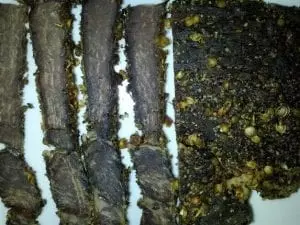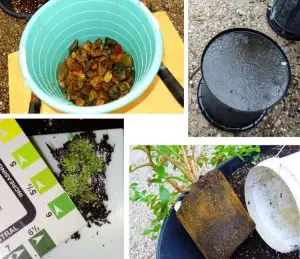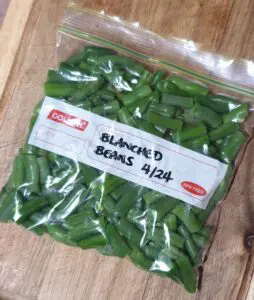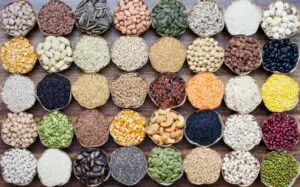Sterilisation is the process whereby all nasty bacteria is killed on or in a container or utensil before usage.
When preserving or storing food in jars or bottles at home it's important to use sterilised vessels and also utensils utilised in the process. Storing food for long periods in non-sterile vessels can make the food spoil and become unsafe to eat due to bacteria already present in the container before the food was introduced.
Importantly, there are two main types of food normally preserved in jars/cans/bottles and they are: low acid foods (like meats, fish, vegetables); and, the more common type for home cooks, high acid foods (like jams, chutneys, pickles).
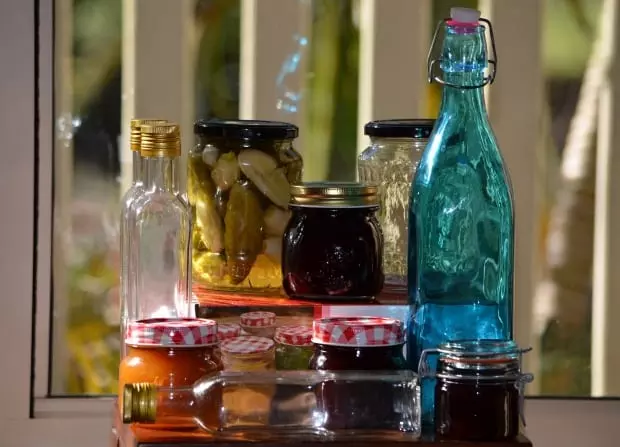
High acid foods can be bottled/canned using less stringent methods because the high acid content of the ingredients used naturally prohibits the growth of bad bacteria. Whereas, bottling or canning low acid foods requires specialised equipment, knowledge, and skill for this to be done safely.  If low acid foods are not processed correctly, the bad bacteria will survive and thrive in the vessel producing a toxin making the contents unsafe to consume.
If low acid foods are not processed correctly, the bad bacteria will survive and thrive in the vessel producing a toxin making the contents unsafe to consume.
Pressure Canning
Botulism or food poisoning is a serious health threat concerning home bottled preserved foods. The truth is these bad bacteria are around us and eaten by us all the time (in small amounts); however, it's only when they are allowed to grow in huge numbers in a confined area that they become a health risk. Whilst all precautions against food poisoning should be taken for any type of food preserving involving bottling, it's particularly risky when canning foods low in acid like meats and vegetables.
For low acid foods, strenuous canning procedures need to be followed to ensure all bad bacteria are killed. This includes boiling the cans, jars, or bottles, at high pressure using specialised equipment and for pre-set high temperatures according to altitude and adhering to other safety considerations. This post does not detail how to bottle low acid foods. The pressure canner image (right) is courtesy of eBay.
Sterilising Bottles and jars for preserving foods high in acid
The instructions about the different sterilising techniques following are meant to be only for the preparation/canning/bottling of high acid and sugar concentrated preserves. Foods like, jams, marmalades, chutneys, pickles, sauces, and other foods with high alcohol, vinegar, sugar, and salt content.
Here are some ways to make jars, bottles, and utensils sterile to use with foods high in acid. The below processes assumes the jars and utensils are clean.
Boil
The boiling water method is probably the simplest and most effective way to sterilise jars and bottles. This process should be done just before bottling is about to be conducted so there is limited time between sterilisation and bottling.
Get a large pot, place the jars, lids, and any utensils to be used in the process into the pot fill with hot water from the tap and then bring to the boil on a stove top. Once the water is at a rolling boil, time it to boil for at least 10 minutes.
After boiling, carefully remove the bottles from the pot by using a specialised jar holder/tongs or some general tongs and place them on a clean towel or kitchen paper and then immediately fill with your preserve and seal.
Hot preserves like jams and marmalades should create a vacuum when cooling drawing air out of the jar making a tight seal usually determined by the top of the lid popping inwards.
Cold preserves like pickled gherkins can be given a hot water bath but are typically not heat treated because we want them to stay firm and not go mushy, plus, the high vinegar content and fermentation process are usually suffice to restrain any dangerous build up of bad bacteria. Having said that, I personally pour my boiled pickling mix over my cucumbers when the mixture is still boiling hot anyway.
Dishwasher
Some people wouldn't be aware a dishwasher can be used to sterilise bottles and equipment for food preserving.
When using this method, ensure your dishwasher is performing to specifications (ie) heating to sterile temperatures and is clean inside. Also, don't wash other dishes etc in with the bottles/jars for obvious reasons.
Oven
Most germs/bacteria are killed at temperatures exceeding 100ºC.
Preheat the oven to about 110ºC and place bottles on a tray in the middle shelf to heat for about 10-15 minutes. Be sure not to over heat as glass may break and don't place cold jars or bottles into a hot oven. Also, do not place a cold product into a very hot jar or it may break.
Glass jars and bottles remain very hot for a length of time after heat treatment so handle with care!
Microwave
If you have ever had children and used a microwave bottle steriliser then you'll know what this is; essentially, it's a container which holds water in the base and uses steam to sterilise. This method can be a low fuss way to sterilise a few small/medium jars.
Naturally, this can only be used for glass and non-metal materials because metals cannot be placed into a microwave. Therefore, things like lids will need to be boiled on the stove top in a small pot to ensure they are sterile also.
Water Bath
This is the act of sterilising after the bottling process where the full jar or bottle is submerged in water and boiled for at least 10 minutes to ensure any bad bacteria are killed.
This method can also help reseal bottles/jars which did not vacuum seal during the cooling process the first time. The lids are replaced and the full jars reheated in the water bath then left to cool and hopefully reseal with vacuum (lid pop).
Signs of contamination or food which has perished
Even if the above sterilising processes are followed to the letter, there may be times when a jar or bottle still becomes contaminated or infected with bad bacteria.
The number 1 rule when using any contained food is to inspect it prior to eating. Open the bottle or jar and inspect for the following:
-
Is it past its use-by date?
-
Are there any signs of growth like a white, black or abnormally coloured culture on or in the product?
-
Check under the lid for growth or excessive rust. Was there any signs of lid swelling or gas escaping upon removal?
-
Does it smell as expected or is it putrid/off?
-
Is the surrounding liquid cloudy or milky?
-
Has the product lost its consistency; for example, is it supposed to be gelatinous but now it's runny?
-
Is there something not quite right about the product?
If you answered “yes” to any of the questions above then you should discard the product.
Conclusion
Don't let the threat of food poisoning prevent you from making your own preserves. If you follow good sterilisation and common-sense food handling practices you shouldn't have any problems.
Nevertheless, we must all be conscious of the fatal threat food poisoning poses and it's our responsibility when making preserves (especially for others) to ensure the product is safe to eat.
Would you like to carry on with this conversation? Then join our new look forum and start a thread in the preserving section (if one hasn't already been started).
You can also make a comment below if you like.
Thanks for your support.
Mark Valencia Editor SSM
Look, and see the Earth through her eyes…


